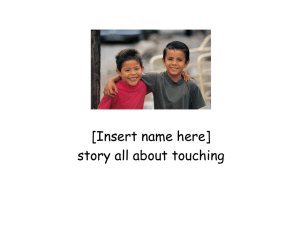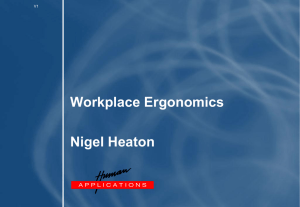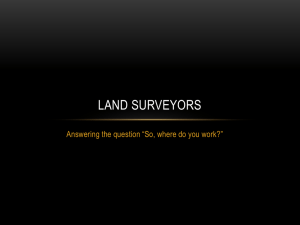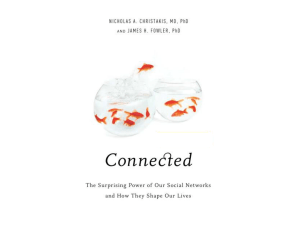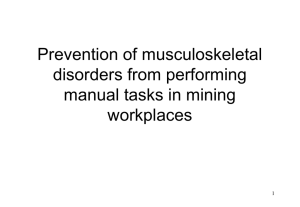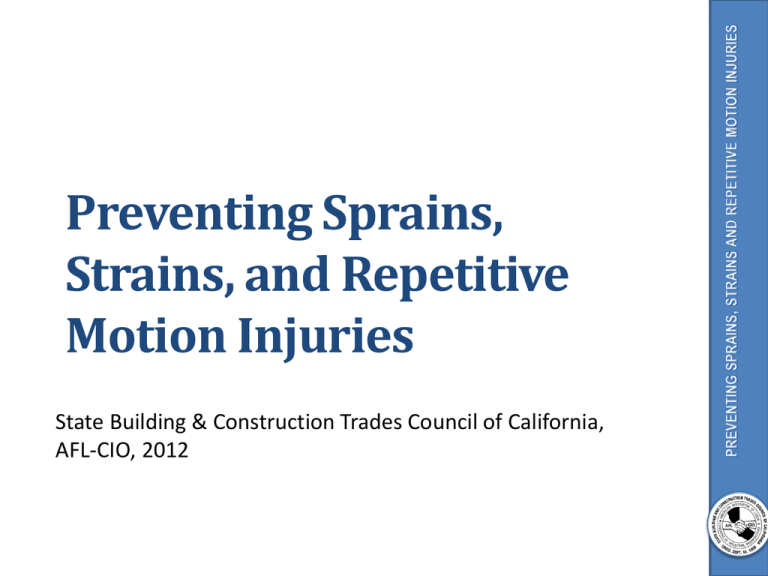
Preventing Sprains,
Strains, and Repetitive
Motion Injuries
State Building & Construction Trades Council of California,
AFL-CIO, 2012
OSHA Grant Number
This material was produced under grant number SH-23588-1260-F-6 from the Occupational Health and Safety Administration,
U.S. Department of Labor. It does not necessarily reflect the
views or policies of the U.S. Department of Labor, nor does
mention of trade names, commercial products, or organizations
imply endorsement by the U.S. Government.
Credits ̶ Sources of Information
• Cal/OSHA
• Worker Occupational Safety and Health Training Program, The
Commission on Health and Safety and Workers' Compensation,
California, Department of Industrial Relations
• The Center for Construction Research and Training (CPWR)
• U.S. Bureau of Labor Statistics, 2003-2009 Survey of Occupational
Injuries and Illnesses and Current Population Survey (Calculations by
the CPWR Data Center.)
• Sue Dong, DrPH, The Center for Construction Research and Training
(CPWR).
• NIOSH
• eLCOSH Images
•
•
•
•
Oregon OSHA Online Course 1201: Introduction to Ergonomics
Washington OSHA (WISHA)
Liberty Mutual, Workplace Safety Index, 2011
Canadian Centre for Occupational Health and Safety (CCOHS)
Workshop Objectives
After completing this workshop, you will be able to:
• Define and explain the terms Musculoskeletal Disorders
(MSDs) and ergonomics.
• Identify 3-5 risk factors for MSD injuries.
• Analyze a job task for risk factors.
• Identify 3-5 solutions to eliminate or reduce MSDs.
• Recognize the elements of a comprehensive ergonomics
program.
Why This Class…
In 2010, 25% of construction injuries were from musculoskeletal
disorders (MSDs).
Photo Credit: Matt Gillen/NIOSH, elcoshimages.org
What Are Musculoskeletal
Disorders (MSDs)?
• An injury or disorder of the
muscles, nerves, tendons,
joints, cartilage, and spinal
discs.
What are some examples of
MSDs?
• Carpal tunnel syndrome
(CTS)
• Tendinitis
• Bursitis
Illustration Source: Occupational Health and Safety Council of Ontario
MSDs: The Leading Construction
Injury
Rate Of MSDs In Construction, By
Selected Occupations, 2003-2009
Source: U.S. Bureau of Labor Statistics, 2003-2009 Survey of Occupational Injuries and Illnesses and Current
Population Survey. Calculations by The CPWR Data Center. Graph: CPWR Data Center.
Days Away From Work, MSDs vs. All Nonfatal
Construction Injuries , 1992-2009
Source: U.S. Bureau of Labor Statistics, 1992-2009 Survey of Occupational Injuries and Illnesses Graph: CPWR Data
Center.
% of MSDs
MSDs By Body Part In
Construction, 2003-2009
Source: U.S. Bureau of Labor Statistics, 2003-2009 Survey of Occupational Injuries and Illnesses,
Current Population Survey. Calculations by The CPWR Data Center. Graph: CPWR Data Center.
Cost Of Injuries
Source: Liberty Mutual Workplace Safety Index Findings
© 2011 Liberty Mutual Group. All Rights Reserved
What Is “Ergonomics?”
Fitting the job to the
Worker.
What Are 4 Terms Commonly
Used For “Ergonomic” Injuries?
• Cumulative trauma disorders (CTDs). Injuries involving
strain which develop, or build up over time.
• Repetitive strain injuries (RSIs). Injuries affecting muscles,
nerves and tendons by repetitive movement and overuse.
The condition mostly affects the upper body.
• Musculoskeletal disorders (MSDs). Injuries and disorders
to soft body tissues including muscles, nerves, tendons,
ligaments, joints, cartilage, and spinal discs.
• Repetitive motion injuries (RMIs). An injury to the body
that is caused by performing the same motion over and
over again thereby straining a body part.
Where Does It Hurt:
Body Mapping Exercise
What Construction Job Tasks
Cause Pain?
“Ouch” Activity
What Risk Factors Can Cause
MSD Injuries?
1.
2.
3.
4.
5.
6.
7.
8.
Awkward postures
Repetition
Excessive Force
Static posture
Vibration
Poorly Designed Tools
Extreme temperature
Poor work organization
Photo Credit: Iron Workers, Washington State Department of Labor and Industries, elcoshimages.org
Awkward Postures
What awkward postures do you work in?
Photo Credit: Iron Workers, Washington State Department of Labor and Industries, elcoshimages.org
Repetition
What jobs require repetition?
Photo Credit: Earl Dotter, elcoshimages.org
Excessive Force
What jobs require excessive force?
Photo Credit: Earl Dotter, elcoshimages.org
Static Posture
What jobs require work in a static or stationary position?
Photo Credit: Mount Sinai/ CHEP, elcoshimages.com.
Vibration
What jobs expose you to vibration?
Photo Credit: John Ruckus/NIOSH, elcoshimages.org
Photo Credit: Mount Sinai/CHEP,
elcoshimages.org
Poorly Designed Tools
What’s the problem with these tools?
Photo Credit: Easy Ergonomics: A Guide to Selecting Non-Powered Hand Tools, Cal/OSHA, NIOSH
Extreme Temperature
Do you work in cold or hot conditions for extended periods of
time?
Photo Credit: NIOSH, elcoshimages.org
Photo Credit: LOHP, Federal OSHA.
Poor Work Organization
This refers to the way jobs are structured, carried out, and
supervised, for example:
• Production schedule demands
• Infrequent rest breaks
• Not enough workers
• Poor planning
• Poor supervision
Have you experienced poor work organization?
Identifying Risk Factors
What are some other ways to identify risk factors on your job?
1.
2.
3.
4.
Employer records (OSHA 300 logs, workers’ comp info., etc.)
Worker surveys or interviews
Walk around inspections
Job evaluations
Photo Source: Cal/OSHA Consultation
Problem Solving
What are some ways to prevent strains, sprains, and
Musculoskeletal Disorders (MSDs)?
•
•
•
•
•
•
•
Better materials
Better tools
Improved work methods
Better work organizaiton
Training
Stretch and flex, and
Personal protective equipment (PPE)
Illustration Source: Simple Solutions, NIOSH
Solution: Better Materials
How can building materials be improved?
Better materials should be:
• Lighter weight
• Packaged in smaller units
• Redesigned – like the blocks in this photo.
Photo Source: NIOSH Publication No. 2007-122: Simple Solutions: Ergonomics for Construction Workers
Solution: Better Hand Tools
Do you use poorly designed tools on your job?
What should you look for in a hand tool?
The best tool is one that:
• Fits the job you are doing
• Fits the work space available
• Reduces the force you need to apply
• Fits your hand
• Can be used in a comfortable work position
Power Tools
How should you select a power
tool?
• It should have a long trigger.
• It should have low vibration and
noise levels.
• It should be heavy enough to do
the job, but not add strain.
Use a power tool instead of a hand
tool when you can.
Photo Source: Ergonomics eTool: Solutions For Electrical Contractors, Federal OSHA
Solution: Improved Work
Methods
How can the work be done differently to reduce risk factors at
your job?
• Use platforms, lifts and forklifts
• Use hoists or chain falls
• Use carts and dollies
• Make smaller loads
• Use power tool instead of hand tools
Power vacuum lifter avoids manual lifting
Solution: Better Planning and
Organization
How can risk factors be reduced by better planning and
organization?
• Plan the work ahead of time
• Deliver materials close to where they will be used
• Have proper equipment at the job site
• Minimize bending, reaching or twisting – work at waist level
whenever possible
• Use the buddy system – get help
Solution: Training
What should training include?
• Risk factors
• Symptoms of MSDs
• Impact of MSDs on workers’ lives
• Solutions
What training have you
received about MSDs or
ergonomics?
Photo Credit: Debra Chaplan, State Building & Construction Trades of California
Solution: Stretching
How many of you have participated in a worksite stretch and
flex program? What are the pros and cons?
Photo Source: University of Washington
Solution: Personal Protective
Equipment (PPE)
The National Institute for Occupational Safety and Health
(NIOSH) recommends that employers not rely on back belts to
protect workers.
What are some examples of PPEs that can help reduce MSDs?
• Shoulder pads
• Knee pads
• Vibration reducing gloves
Implementing Solutions
What are some challenges implementing solutions?
• Costs too much
• Slows down production
• Equipment not available
• Change isn’t easy
Preventing MSD hazards is less
expensive and more effective than
trying to control them later.
Small Group Activity - Solutions
• Break into small groups.
• View construction photo.
• Complete Construction Solutions Worksheet:
• Identify risk factors
• Identify solutions
• What changes can the worker make on his/her own?
• What changes can a contractor make?
• What can the union do?
• Each small group reports back on their findings.
Small Group #1: Screeding
Photo Credit: Cement Masons/Washington State Department of Labor and Industries, elcoshimages.com
Screed Solutions
Manual Screed
Roller screed
Walk-behind screed
Photo Source: Ergonomic Interventions in Construction: Evaluation, Diffusion, and Adoption, Steve Hecker
Small Group #2: Handling
Drywall
Photo Source: Ergonomic Interventions in Construction: Evaluation, Diffusion, and Adoption, Steve Hecker
Drywall Solutions
Photo Source: Ergonomic Interventions in Construction: Evaluation, Diffusion, and Adoption, Steve Hecker
Small Group #3: Rebar Tying
Photo Source: Construction Solutions: Solution: Rebar-Tying Tools, CPWR
Rebar Tying Solution
Photo Source: Rebar-Tying Machines Part 1 (Part of Construction Safety
Magazine, Volume 12, Number 4, Winter 2001/02, Ontario Canada.)
Photo Source: Construction Solutions: Solution: Rebar-Tying Tools, CPWR
Small Group #4: Overhead
Drilling
Photo Credit: NIOSH/John Rekus, elcoshimages.org
Overhead Drilling Solution
Photo Source: Ergonomics, David Rempel, University of California
Small Group #5: Caulking
Photo Source: Construction Solutions: Solution: Power Caulking Guns, CPWR
Power Caulking Gun Solution
Photo Source: Construction Solutions: Solution: Power Caulking Guns, CPWR
What Can You Do To Get
Solutions Implemented?
• What changes can the worker do on his/her own?
• What changes can a contractor make?
• What can the union do?
Illustration Source: NIOSH Publication No. 2007-122: Simple Solutions: Ergonomics for Construction Workers
Cal/OSHA’s Ergonomics
Standard
The standard requires employers to take action to prevent
repetitive motion injuries if:
• Two workers have reported repetitive motion injuries within a
12-month period
—and—
• These injuries are a result of performing identical work and
are diagnosed by a physician.
Components of an Ergonomics
Program
What should be included in an Ergonomics program to reduce
MSDs?
• Management commitment and worker involvement
• Hazard Information and Reporting
• Job Hazard Analysis and Control
• Training
• MSD Medical Management
• Program Evaluation
Workers Are The Experts
Participatory Ergonomic Programs emphasize worker
participation and include five steps:
1) identification of musculoskeletal disorders and workplace
hazards that may cause these problems,
2) analysis of workplace hazards,
3) development of solutions to reduce or eliminate hazards,
4) implementation of solutions, and
5) evaluation of the solution's effectiveness.
Workshop Review
What key points did you learn in this workshop?
1.Ergonomics is the process of fitting the job to the worker.
2.Musculoskeletal Disorders (MSDs) are injuries affecting the
muscles, bones, tendons, ligaments, nerves, and soft body
tissues.
3.MSDs are one of the most costly workplace injuries.
4.MSD risk factors include: awkward postures, repetition,
excessive force, static posture, vibration, poorly designed tools,
extreme temperature, poor work organization.
5.Solutions include: better materials, better tools, improved work
methods, better work organization, training, stretching, and
personal protective equipment (PPE).
6.Cal/OSHA has an ergonomics standard, but it is very limited.
7.A comprehensive ergonomics program involves workers.
Workshop Evaluation
• Thank you for attending the workshop.
• Please take a moment to evaluate this workshop so we can
improve it.




